Space Weather Observations, Alerts, and Forecast
Current Space Weather Overview

|
Tweets by _SpaceWeather_ |
3-day Solar-Geophysical Forecast
Product: 3-Day Forecast
- Issued: 2025 May 08 0030 UTC
Prepared by the U.S. Dept. of Commerce, NOAA, Space Weather Prediction Center.
Geomagnetic Activity Observation and Forecast
The greatest observed 3 hr Kp over the past 24 hours was 3 (below NOAA Scale levels). The greatest expected 3 hr Kp for May 08-May 10 2025 is 4.67 (NOAA Scale G1).
| May 08 | May 09 | May 10 | |
|---|---|---|---|
| 00-03UT | 2.67 | 3.33 | 3.67 |
| 03-06UT | 2.33 | 3.67 | 3.00 |
| 06-09UT | 2.67 | 3.67 | 2.67 |
| 09-12UT | 2.33 | 3.67 | 2.00 |
| 12-15UT | 2.00 | 3.67 | 2.67 |
| 15-18UT | 2.00 | 4.00 | 2.00 |
| 18-21UT | 2.33 | 4.67 (G1) | 2.67 |
| 21-00UT | 2.67 | 4.00 | 2.67 |
Rationale: G1 (Minor) conditions are likely on 09 May due to the onset of influence from another negative polarity CH HSS coupled with a possible glancing blow CME from 05 May.
Solar Radiation Activity Observation and Forecast
Solar radiation, as observed by NOAA GOES-18 over the past 24 hours, was below S-scale storm level thresholds.
| May 08 | May 09 | May 10 | |
|---|---|---|---|
| S1 or greater | 5% | 5% | 5% |
Rationale: No S1 (Minor) or greater solar radiation storms are expected. No significant active region activity favorable for radiation storm production is forecast.
Radio Blackout Activity and Forecast
No radio blackouts were observed over the past 24 hours.
| May 08 | May 09 | May 10 | |
|---|---|---|---|
| R1-R2 | 45% | 45% | 45% |
| R3 or greater | 5% | 5% | 5% |
Rationale: Region 4079s enhanced magnetic complexity will keep the chance for R1-R2 (Minor-Moderate) radio blackouts in the forecast over 08-10 May.
Real Time Images of the Sun
SOHO EIT 171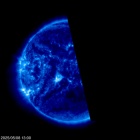
|
SOHO EIT 195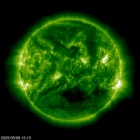
|
SOHO EIT 284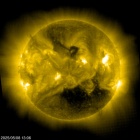
|
SOHO EIT 304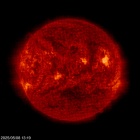
|
SDO/HMI Continuum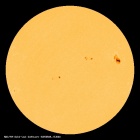
|
SDO/HMI Magnetogram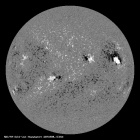
|
LASCO C2
|
LASCO C3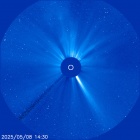
|
Solar Wind
Real-Time Solar Wind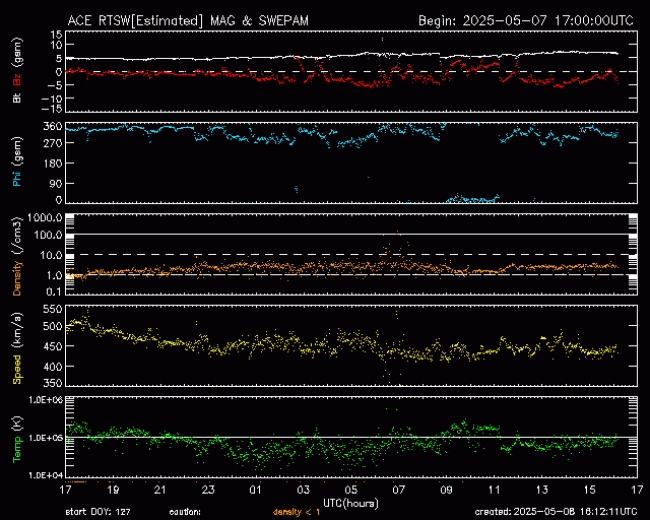
Real-Time Solar Wind data broadcast from NASA's ACE satellite. |
WSA-Enlil Solar Wind Prediction
|
| Move your cursor over the timeline to 'scrub' through the forecast. |
Solar Cycle
The Solar Cycle is observed by counting the frequency and placement of sunspots visible on the Sun. The forecast comes from the Solar Cycle Prediction Panel representing NOAA, NASA and the International Space Environmental Services (ISES). The Prediction Panel has predicted Cycle 25 to reach a maximum of 115 occurring in July, 2025. The solar radio flux at 10.7 cm (2800 MHz) is an excellent indicator of solar activity. Often called the F10.7 index, it is one of the longest running records of solar activity. The F10.7 radio emissions originates high in the chromosphere and low in the corona of the solar atmosphere. The F10.7 correlates well with the sunspot number as well as a number of UltraViolet (UV) and visible solar irradiance records.
Auroral Activity Forecast
Northern Hemi Auroral Map
|
Southern Hemi Auroral Map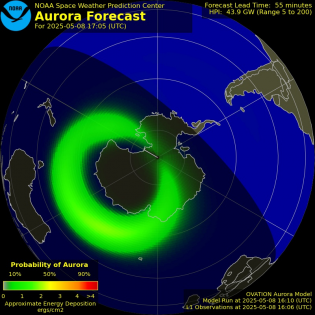
|
Radio Communications Impact
D-Region Absorption
D-Region Absorption Prediction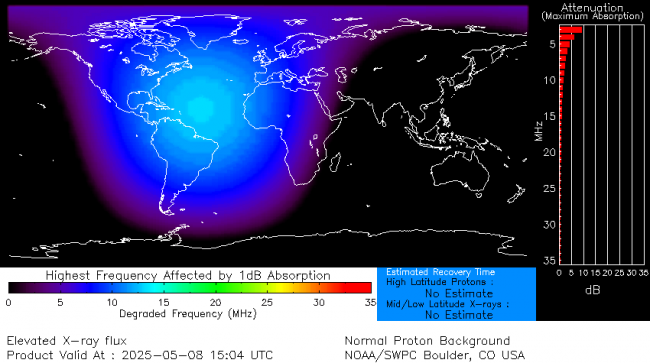
|
VHF and HF Band Conditions
|
|
|
Credits:
Space Weather Images and Information (excluded from copyright) courtesy of:NOAA / NWS Space Weather Prediction Center
Mauna Loa Solar Observatory (HAO/NCAR)
SOHO (ESA & NASA).
Space Weather links:
3-Day Forecast of Solar and Geophysical Activity
Space Weather Overview
LASCO Coronagraph
Real-Time Solar Wind
Space Weather Advisory Outlooks
Space Weather Forecast Disussions
Space Weather Alerts, Watches and Warnings
Solar and Heliospheric Observatory (SOHO)
The Very Latest SOHO Images
Powered by Space Weather PHP script by Mike Challis
additions by Martin of Hebrides Weather and Ken True of Saratoga Weather
with 3-day Solar-Geophysical Forecast text formatting by Jeremy Dyde of Jerbils Weather








 Feed
Feed Scan with QR Code Reader
Scan with QR Code Reader mobi
mobi



